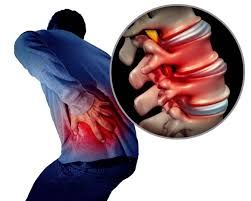Lumbar Spinal Stenosis

The field of interventional pain management has gone through a revolution in the past two years! We are pushing the envelope on minimally invasive treatments that once-upon-a-time were only possible through major surgery. In this featured article, we highlight minimally invasive treatments for Lumbar Spinal Stenosis.
What is Lumbar Spinal Stenosis?
Narrowing of the spinal canal is referred to as spinal stenosis. As the spine ages, degenerative changes lead to narrowing of the spinal canal. You can think of the spinal canal as a tunnel created by surrounding bones, ligaments, and intervertebral discs. The “discs” bulge over time encroaching upon the spinal canal. As the wall of the disc weakens, the disc itself will bulge (imagine what happens when you squeeze a water balloon). This causes compression of the spinal canal from the front. Simultaneously, the ligament called the “ligamentum flavum” becomes thick. This ligament connects adjacent segments of the spine. When it becomes thick, it compresses the spinal canal from behind. Finally, the facet joints on either side of the spine become enlarged as a result of arthritis. We call this “facet hypertrophy,” and it causes compression of the spine from both sides.
What are the symptoms of Lumbar Spinal Stenosis?
- Pain in the low back with radiation into the legs
- Walking with a stooped forward posture
- Pain relief with sitting
- Bending over a shopping cart to relieve pain
- Numbness and tingling in the legs
- Pain radiating into the legs
What Minimally Invasive treatments are available for Lumbar Spinal Stenosis?
Previously, the only available treatment to decompress the spinal canal was through open surgery. Recovery was oftentimes protracted and painful. We now have minimally invasive procedures that allow for improvement without the prolonged recovery and post surgical pain. The less invasive procedures can provide excellent relief. They are performed at an outpatient surgery center rather than a hospital, and sedation is provided through an IV without the need for general anesthesia. The two minimally invasive procedures include Minimally Invasive Lumbar Decompression (MILD) and Vertiflex.
- MILD Procedure
- This procedure decompresses the spinal canal by shaving the thickened ligament that pushes on the spinal canal from behind
- A very small nick incision is created on the skin through which the pen-sized instrument is placed with x-ray guidance
- Results of the MILD procedure show the following:
- Walking Distance
- Standing Time
- Pain Relief
- Click on the link to see a video animation of the procedure:
- Vertiflex Procedure
- This procedure inserts a spacer between two vertebral levels in order to create more space at the level of stenosis
- Through a one centimeter long incision, the spacer is placed between the spinous processes of the spine
- Results of the Vertiflex procedure show the following:
- 66% of patients reported relief of their low back pain
- 75% of patients reported relief of their leg pain
- 95% of patients reported pain relief 5 years after their procedure
- Click on the link to see an animation of the procedure:


Recent Comments